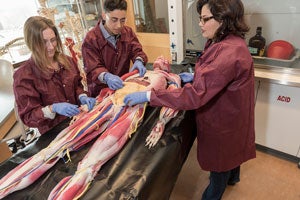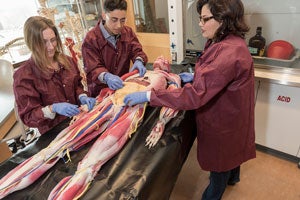 KINGSTON, R.I. – April 5, 2016 – The four synthetic human cadavers the University of Rhode Island acquired last month have the look and feel of real bodies, though they have no skin covering the muscles, organs and skeleton. Faculty and staff say the full-size models, which are stored in water tanks to maintain their life-like texture, are a huge improvement over the hard plastic models previously used to teach anatomy to undergraduate students.
KINGSTON, R.I. – April 5, 2016 – The four synthetic human cadavers the University of Rhode Island acquired last month have the look and feel of real bodies, though they have no skin covering the muscles, organs and skeleton. Faculty and staff say the full-size models, which are stored in water tanks to maintain their life-like texture, are a huge improvement over the hard plastic models previously used to teach anatomy to undergraduate students.
“We wanted to give our students an experience similar to what medical school students get with real human cadavers,” said Aura Grandidge, URI’s manager of undergraduate biology labs, who is developing a hands-on curriculum using the cadaver models. “They will significantly improve the way students learn about anatomy.”
Manufactured by SynDaver Labs in Tampa, Fla., the synthetic human cadavers include the complete bone structure, muscles, tendons and ligaments, fully articulating joints, a complete respiratory system, digestive tract, circulatory system, urinary tract and reproductive organs. In addition to anatomy education, they can also be used in medical training, surgical simulations and medical device testing.
URI is just the second university in New England to acquire the synthetic human cadavers and the only school with more than one.
Beginning next fall, freshmen enrolled in a course on human anatomy will dissect the models as part of their anatomy lab, as will upperclassmen studying comparative anatomy. More than 1,000 students each year will work with the models.
“One of the challenges of studying muscles, nerves, the circulatory system and other aspects of human anatomy is that it’s difficult for students to put everything in context,” Grandidge said. “Traditionally we use plastic models to learn anatomy, which makes it more challenging for students to understand how everything goes together.”
As Grandidge works with URI Assistant Professors Bryan Dewsbury and Kimberly Fournier on the curriculum, they hope to incorporate pathologies like cancer or smoker’s lungs into the cadaver models as well.
“We want students to be able to study healthy cadavers and compare them with models that have pathologies,” she said. “It will give students a chance to hunt for something unexpected when they’re looking at the cadavers.”
Dewsbury and Fournier will also invite select public schools in the region to visit the anatomy lab and use the new models in age-appropriate lessons.
Each cadaver model cost about $40,000. The purchase was made possible with a private grant award and University funds. The URI Foundation’s Office of Corporate and Foundation Relations assisted with grant application support. Additional private support is sought to cover the ongoing expense of maintaining the models. Those interested in contributing should contact Kari Van Buren at the URI Foundation at karivanburen@uri.edu or 401-874-2446.
Pictured above: URI lab manager Aura Grandidge (right) and students Katharine Harrison (left) and Jesse Boukarim study one of the new synthetic human cadavers URI acquired as a teaching aid in human anatomy courses. (Photo by Michael Salerno)

